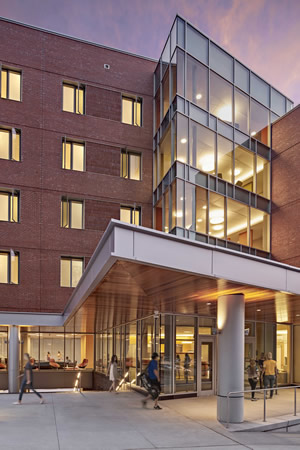Designing for Sustainability: The Case for Early Intervention
This call to action explores the missed/lost opportunity when sustainability planning for higher ed projects begins too late in the game.
A recent trend we see among higher education clients is a reluctance to pursue LEED and other third-party sustainability certifications. Even as the available options for certification or rating such as WELL, Living Building Challenge, FitWell, TRUE, PassiveHaus, and Green Globes continue to grow, institutions are delaying decisions to commit.

Photo courtesy of ARC/Architectural Resources Cambridge
For some, the added expense associated with registering, administering, and completing a project for certification is a deterrent. For others, internal debate on whether the initial cost of a sustainable building program in comparison to a more "conventional" building slows the decision process.
Often, we also see an extended period of consensus-building and stakeholder dialogue on issues such as curriculum changes, technology investments, and funding sources for a new facility. Sustainability planning is set aside as budgets are developed, the program is defined, and schedules are set.
Most decision makers eventually opt for a sustainably designed project, even when their conclusion is to forgo formal certification. But the unintended consequences of delay and debate scenarios include a) missed opportunities in the early stages, and b) greater difficulty meeting the eventual goals for savings and sustainability due to late-stage commitment.
Setting Strategy Early
When all stakeholders move into the process with a shared goal of sustainability early on, all options can be considered, examined, and tested. Early intervention allows the team to evaluate a range of actions related to building orientation, site, massing, programming, mechanical systems, and building envelope.
For the 316-bed West Hall residence hall at Framingham State University, planning began in the earliest concept and feasibility stages to capture high-value, high-payback opportunities. To reduce up-front costs and increase the return on investment, only approaches that reinforced each other were selected, modeled, and cost analyzed.
For example, mechanical systems were evaluated in tandem with building envelope assemblies to identify the most cost-effective combination that maximizes building performance. While the project initially targeted LEED Silver certification, this building achieved LEED Gold, falling just a few points short of LEED Platinum without bearing the typical first-cost premiums.
Working with Collective Purpose
Even under the best of circumstances, achieving sustainability goals can be challenging. We recommend hosting a sustainability kickoff session early on with all parties—owner, architect, consultants and other stakeholders—to establish goals and advance a shared purpose. The discussion should include determining the types of post-occupancy performance data to be collected. A shared consensus provides the design team and client with goals to design toward as well as methods to evaluate the performance of the building against established targets.
Next, to achieve the goals set at this session, we recommend a comprehensive sustainability review. The objectives are to investigate options within the building program, review the sustainable systems and practices already in place on campus, and explore options to extend existing practices to full benefit. These practices, including energy management, waste management, potable water use, material selection, resiliency standards, and building maintenance protocols will help generate a design that complements past initiatives and builds on them to improve performance in the new facility.
Modeling to Reveal Unseen Early Opportunities
In our experience, energy modeling is the single best investment for sustainability success. It is the primary tool used to establish energy budgets and provides the only accurate basis of comparison and evaluation of the possible design strategies and components in terms of efficacy, ROI, and life-cycle costs.
When modeling starts with early design efforts, an integrated team can tap the growing sophistication and accuracy of the technology to achieve precise results. While some pause at the first costs, evidence of its value, as measured by both savings delivered and costs avoided, tangibly supports the expense. Without an energy model, it’s impossible to know whether triple-glazed windows are worth the cost, for example, or whether the addition of four inches of insulation will appreciably increase the R-value of the roof.
By opening up design opportunities and providing a framework for what can be a fractious process, the financial and environmental benefits of an early start will be experienced by all participants. Ultimately, the teams ready to think early, think big, and think toward the future will achieve results bound to ripple across the entire campus for generations to come.
About the Author
Alisa Nagano, AIA, LEED-AP BD+C, is an associate with ARC/Architectural Resources Cambridge and leads the firm’s AIA 2030 initiative. She can be reached at [email protected].